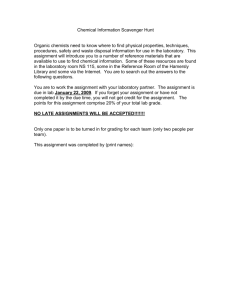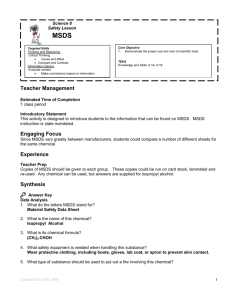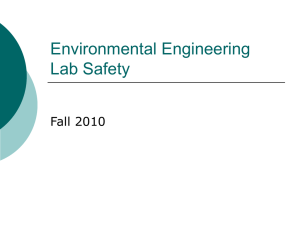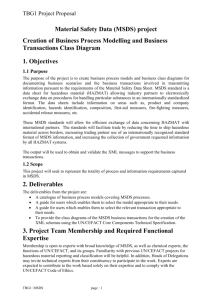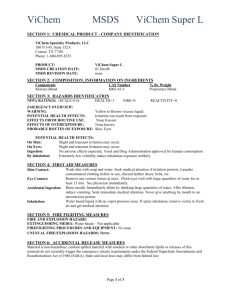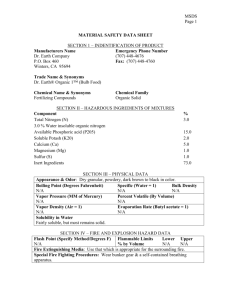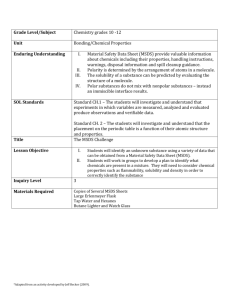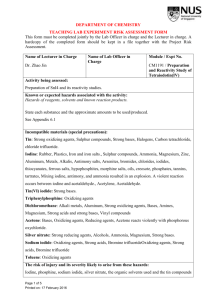Chemical Information Scavenger Hunt
advertisement
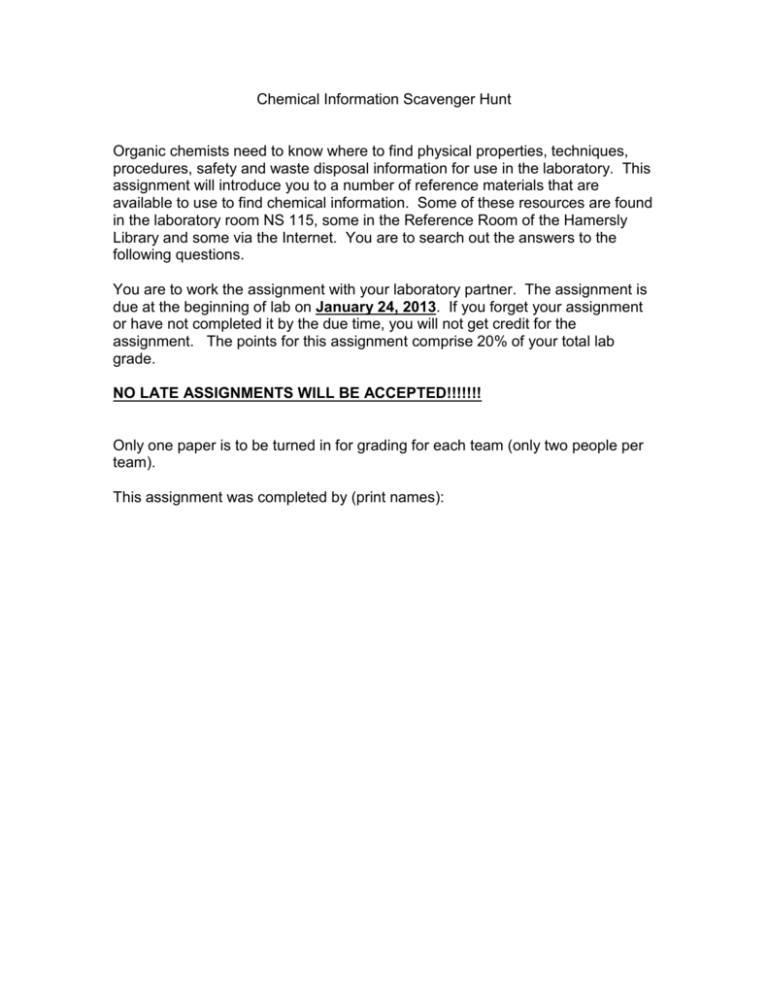
Chemical Information Scavenger Hunt Organic chemists need to know where to find physical properties, techniques, procedures, safety and waste disposal information for use in the laboratory. This assignment will introduce you to a number of reference materials that are available to use to find chemical information. Some of these resources are found in the laboratory room NS 115, some in the Reference Room of the Hamersly Library and some via the Internet. You are to search out the answers to the following questions. You are to work the assignment with your laboratory partner. The assignment is due at the beginning of lab on January 24, 2013. If you forget your assignment or have not completed it by the due time, you will not get credit for the assignment. The points for this assignment comprise 20% of your total lab grade. NO LATE ASSIGNMENTS WILL BE ACCEPTED!!!!!!! Only one paper is to be turned in for grading for each team (only two people per team). This assignment was completed by (print names): Part I. The CRC Handbook. The CRC Handbook contains a wealth of information, most of it in tabular form. You will need to search through the volume to find the appropriate sections for use in answering the following questions. There are several CRC Handbooks in the laboratory and also one at the library. For each question, include the number of the edition and the page on which you found your answer. If you do not include this information, you will not receive credit for the question. 1. What is the only mineral that contains the element cadmium of any consequence? 2. What is the formula and formula weight for manganese selinite? 3. TNT is 2,4,6-trinitrotoluene. 4. (a) What is the melting point of TNT? (b) In which common solvents is it soluble? (c) What important note is made about its boiling point? Saccharin is a compound that has been used as a sweetening agent. What is its structure? 5. In the past, tetraethyllead was used as a gasoline additive (leaded gas). Is it soluble in cold water? 6. Valine is one of the 20 common -amino acids. What is its isoelectric point (pI)? 7. What is an azeotrope? (NOTE: you won’t find this definition in the CRC) 8. Ethanol and water form a binary azeotrope. What is the boiling point of this azeotrope at atmospheric pressure? 9. According to the CRC, how would you prepare Aqua Regia, a mixture that is often used for cleaning laboratory glassware? 10. What is the first ionization potential for sodium? 11. What is the first ionization potential for neon? 12. Using the temperature conversion table, to what value on the Fahrenheit scale is 37oC equivalent? 13. A person weighs 150 pounds. How many slugs does that person weigh? 14. We measure pressures in terms of atmospheres or torr. The evening weather report gives pressures in terms of inches of mercury. (a) 1atm equals how many inches of mercury? (b) How many torr is this? Part II. The Material Safety Data Sheet. Material Safety Data Sheets or MSDS are very important documents as they contain information about the hazards of chemicals and products containing chemicals. Chemical companies are required by law to make MSDS available for every chemical that they market. In this part of the assignment, you will learn how to locate and read a MSDS. Learn about reading an MSDS using the links on the Moodle site. 15. Use the SIRI MSDS Index (http://hazard.com/msds/index.php) to find the MSDS for 3% hydrogen peroxide (the stuff in your medicine cabinet) and 30% hydrogen peroxide. Compare the hazards of the two concentrations. 16. Find an MSDS for calcium carbide. If there is a fire, and calcium carbide is present, what type of extinguishing agent should you use to put out the fire? 17. At one time diethyl ether was a commonly used anesthetic. Using the MSDS information, explain why it is not a very good choice. 18. Use the MSDS notebooks on the shelf of NS 115 (organic lab) to answer this question. A student accidentally drinks some MTBE thinking it is water. The student is taken to the health center for treatment, and MSDS sheet from the lab is consulted. According to this MSDS, how should the student be treated? Part III. Library Resources The Chemist’s Companion is located in the Reference Room of the Hamersly Library. Use this handbook to answer the following questions. Include the page number on which the information needed was found. 19. You need to carry out a chemical reaction at –77 oC. Explain how you would prepare a low temperature cooling bath of –77 oC. 20. How would you prepare a salt-ice cooling bath of approximately –15 oC. 21. Silicon lubricant is often used to “grease” the ground glass joints of lab glassware. Attach a photocopy of the infrared (IR) spectrum of silicon lubricant. 22. Alcoholic sodium hydroxide is a powerful glassware cleaning solution. (a) How would you prepare it? (b) What can happen to your glassware on prolonged exposure? 23. Icosane has a boiling point of 344 oC at atmospheric pressure (1 atm or 760 mm). If you distill the icosane under vacuum at a pressure of 1 mm, what will be its boiling point? Use the Pressure-Temperature Alignment Chart found in The Chemist’s Companion to answer this question. Use the Hazardous Laboratory Chemicals Disposal Guide to answer the next question. It is found in the Reference Room. 24. You need to dispose of 2 mL of aniline as waste. Write an exact procedure for accomplishing this. Use the ACS Style Guide from the Reference Room to answer the following questions. 25. What CASSI abbreviation for the following journals is used in citing information obtained from articles in these journals? (a) The Journal of Organic Chemistry (b) Environmental Science & Technology 26. If you use information from a website in writing a chemistry paper, you need to cite (footnote) that website just as you would information from any other book or journal article. What is the recommended format for an internet source? 27. Write a correct reference for the chapter on interpreting a handbook found in The Organic Chem Lab Survival Manual found in the laboratory.
